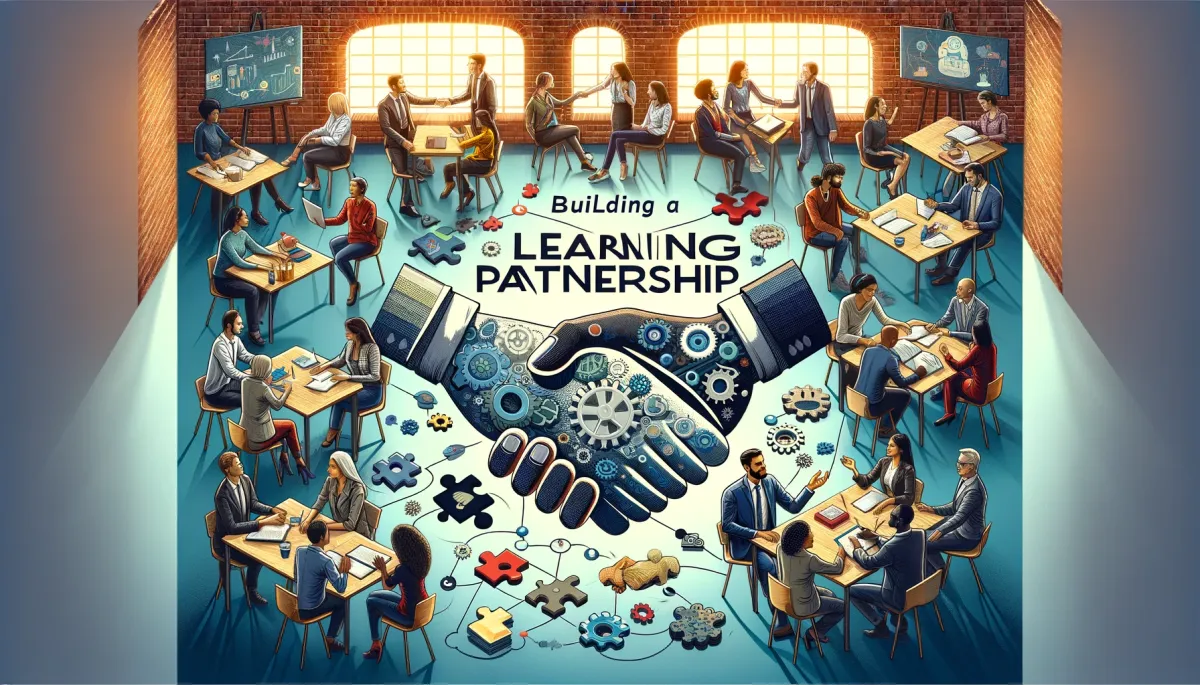Maintaining Student Engagement in Online Tutoring

Fanie Naude
CEO & Founder of Knowledgeable Tutor, Buznet Direct, YMC & Naude Consulting

Fanie Naude
CEO & Founder of Knowledgeable Tutor, Buznet Direct, YMC & Naude Consulting
11. Building a Learning Partnership
12. Setting Expectations and Modeling Engagement
14. Course Design for Engagement
15. Accessibility and Inclusion
18. Quality Assurance in Online Tutoring
19. Legal and Ethical Considerations in Online Tutoring
20. Case Studies: Real-world Examples of Successful Online Tutoring Programs
21. Future Trends in Online Tutoring
22. Common Pitfalls and How to Avoid Them
23. FAQs: Questions Commonly Asked by Both Tutors and Students

1. Introduction
"Education is not the filling of a pail, but the lighting of a fire." - William Butler Yeats
In the digital age, where the boundaries of classrooms have expanded beyond four walls, the challenge of maintaining student engagement in online tutoring has become increasingly significant. As the great educator William Arthur Ward once said, "The great teacher inspires." But how can one inspire through a screen? This article aims to be your comprehensive guide to understanding and implementing strategies that not only maintain but elevate student engagement in an online tutoring setting. We will delve into the psychology of engagement, explore technological tools, and offer actionable strategies backed by data and real-world examples.
Summary of the Article
- Positivity: Discusses the impact of a positive learning environment on student engagement, citing a study by the Journal of Educational Psychology.
- Personalization: Emphasizes the importance of tailoring the learning experience to individual student needs.
- Ethical Practices: Addresses the need for secure storage of recorded sessions and academic integrity.
- Motivation and Interest: Quotes Jim Rohn and explores the role of motivation and interest in student engagement.
- Technology Tools: Provides insights on various technology platforms like Zoom, Skype, and interactive whiteboards for effective online tutoring.
- Parent-Teacher Meetings: Highlights the significance of regular parent-teacher meetings conducted via video conferencing tools.
- Modular Course Design: Advocates for breaking down course material into smaller, manageable modules for greater flexibility.
- Real-Life Examples: Includes case studies like Duolingo's use of achievement badges to motivate language learners.
"Education is the most powerful weapon which you can use to change the world." - Nelson Mandela

2. The Psychology of Student Engagement
What Engages Students?
"Tell me and I forget. Teach me and I remember. Involve me and I learn." - Benjamin Franklin
Understanding what engages students is the cornerstone of effective online tutoring. According to a study by Schlechty, student engagement can be categorized into five levels: Engagement, Strategic Compliance, Ritual Compliance, Retreatism, and Rebellion. The goal is to move students from mere compliance to genuine engagement where they find value in their learning activities.
- Intrinsic Motivation: Students who are intrinsically motivated are naturally curious and eager to learn. They find the learning process itself rewarding.
- Extrinsic Motivation: This involves external rewards such as grades, praise, or certificates. While not as powerful as intrinsic motivation, it can be a useful tool.
- Relevance: Students are more likely to engage when they find the material relevant to their lives or future careers.
- Challenge: A balanced level of difficulty can stimulate students' minds without overwhelming them.
The Role of Motivation and Interest
"Motivation is what gets you started. Habit is what keeps you going." - Jim Rohn
Motivation and interest are the driving forces behind student engagement. A study by the University of Rochester found that students who perceive their classroom activities as interesting and valuable are more likely to engage. Here are some key points:
- Self-Determination Theory: This theory suggests that conditions supporting the individual’s experience of autonomy, competence, and relatedness are conducive to high-quality motivation.
- Goal-Setting: Encourage students to set achievable goals. This not only gives them a sense of direction but also a sense of accomplishment when they achieve these goals.
- Interests and Passions: Tutors should take the time to understand their students' interests and passions and integrate them into the tutoring sessions.
In summary, understanding the psychology of student engagement is not just beneficial but essential for tutors aiming to make their online sessions more effective. The key lies in balancing various motivational factors and making the learning experience relevant, challenging, and rewarding for the students.
Stay tuned as we delve into the technological tools that can further enhance student engagement in the next section.

3. Technological Tools for Engagement
In the digital age, technology serves as the backbone of effective online tutoring. The right technological tools can make or break the student engagement factor. As the saying goes, "Technology will not replace great teachers but technology in the hands of great teachers can be transformational." - George Couros.
Video and Audio Interactions
The first line of engagement in online tutoring is often through video and audio interactions. Platforms like Zoom or Skype offer real-time video and audio capabilities that mimic the traditional classroom setting. These platforms provide features like breakout rooms, screen sharing, and real-time annotations, which can significantly enhance the learning experience.
For more insights on tools and technology, check out our guide on Tools and Technology for Effective Online Tutoring.
Interactive Whiteboards
Interactive whiteboards like Ziteboard or BitPaper offer a shared space for tutors and students to collaborate. Whether it's solving a complex calculus problem or brainstorming for an essay, these whiteboards offer real-time collaboration that can be incredibly engaging.
Gamification Tools
Gamification tools like Kahoot or Quizizz add a fun element to the learning process. These platforms allow tutors to create interactive quizzes and games that can serve as both assessment and engagement tools.
| Tool | Purpose | Engagement Factor |
|---|---|---|
| Zoom | Video and Audio Interaction | High |
| Ziteboard | Interactive Whiteboard | Medium |
| Kahoot | Gamification | High |
Parable: The Orchestra of Engagement
Imagine an orchestra where each instrument represents a different technological tool. The conductor, symbolizing the tutor, must ensure each instrument plays in harmony to create a beautiful symphony—that's the epitome of student engagement through technology.

4. The Four P's of Engagement
The Four P's of Engagement serve as the pillars that uphold the structure of effective online tutoring. These are Positivity, Personalization, Pitch, and Pace.
Positivity
A positive learning environment can significantly impact student engagement. A study by the Journal of Educational Psychology found that positivity increases students' attention and focus.
Personalization
Personalization involves tailoring the learning experience to meet the individual needs of each student. Adaptive learning systems and personalized feedback are key elements here. As Bill Gates once said, "Personalized learning will not replace teachers, but empower them."
For more on personalization, read our article on Creating Effective Lesson Plans for Online Tutoring.
Pitch
The pitch refers to the level of complexity of the material being taught. It's crucial to match the pitch with the student's current understanding of the subject to avoid disengagement.
Pace
The pace at which the material is covered can also impact engagement. Too fast, and you risk overwhelming the student; too slow, and the student may lose interest.
| The Four P's | Description | Impact on Engagement |
|---|---|---|
| Positivity | Creates an uplifting learning environment | High |
| Personalization | Tailors the learning experience to individual needs | High |
| Pitch | Matches the complexity level of the material with the student's understanding | Medium |
| Pace | Controls the speed at which the material is covered | Medium |
Parable: The Master Chef of Engagement
Consider a master chef preparing a gourmet meal. Each of the Four P's is like an essential ingredient—salt (Positivity), spice (Personalization), texture (Pitch), and time (Pace). Missing any of these would make the dish less appealing, just as neglecting any of the Four P's could lead to disengagement.
For an in-depth look at maintaining student engagement, explore our comprehensive guide on Maintaining Student Engagement in Online Tutoring.
In the next sections, we will delve into active learning strategies and the role of feedback in maintaining student engagement. Stay tuned for more insights and actionable tips.

5. Active Learning Strategies
Active learning is not just a buzzword; it's a fundamental approach to education that actively engages the student in the learning process. This is particularly crucial in an online tutoring environment where the physical cues of a traditional classroom are absent.
Problem-solving Sessions
One of the most effective ways to engage students is through problem-solving sessions. These sessions can be tailored to the subject matter, whether it's a complex calculus problem or a thematic analysis of a literary work. The key is to present challenges that require students to apply their knowledge in new and interesting ways. This not only keeps the student engaged but also reinforces the learning objectives. As Confucius once said, "I hear and I forget. I see and I remember. I do and I understand."
For more on this, check out our guide on Creating Effective Lesson Plans for Online Tutoring.
Group Discussions
Another active learning strategy is the facilitation of group discussions. This can be done through breakout rooms in virtual classrooms. Group discussions encourage students to articulate their thoughts, ask questions, and defend their viewpoints. This form of peer-to-peer learning can be incredibly effective in reinforcing educational content and enhancing critical thinking skills.
Real-world Applications
The ultimate goal of education is not just to fill the student's mind with facts but to prepare them for the real world. Therefore, incorporating real-world applications into your tutoring sessions can make the subject matter come alive. For example, a history tutor might discuss the implications of past events on current geopolitics, while a science tutor could demonstrate how basic principles can explain everyday phenomena.
For more insights, visit our article on Teaching Different Subjects: Tips and Techniques.

6. The Role of Feedback
Feedback is the breakfast of champions, as Ken Blanchard aptly put it. In the realm of online tutoring, timely and constructive feedback can make all the difference in maintaining student engagement.
Timely Feedback
The digital age has conditioned us for instant gratification. While education should aim to temper this impulse, it's also true that timely feedback can greatly aid the learning process. Whether it's immediate correction during a lesson or prompt grading of an assignment, quick feedback loops keep students engaged and informed about their progress.
For more on this, explore our guide on How to Give Effective Feedback to Online Students.
Types of Constructive Feedback
Feedback can be formative or summative, qualitative or quantitative. Formative feedback is ongoing and happens during the learning process, while summative feedback occurs at the end of an instructional period. Both are essential for student growth. Qualitative feedback provides in-depth insights into performance, whereas quantitative feedback gives measurable data that can be used for improvement.
In summary, active learning strategies and constructive feedback are not just educational theories; they are practical tools that can significantly enhance the quality and effectiveness of online tutoring. By incorporating these elements into your teaching methods, you can ensure a more engaging and fruitful educational experience for your students.

7. The Importance of Transparency in Online Tutoring
"Transparency is the currency of trust." - Unknown
In the realm of online tutoring, transparency is not just a buzzword; it's a cornerstone for building a strong tutor-student relationship. It's about setting clear expectations and maintaining open channels of communication. This is crucial for both parties to be on the same page, which in turn, enhances the quality of the tutoring session.
Setting Expectations
- Course Outline: Before the course begins, provide a detailed outline that includes the topics to be covered, the learning objectives, and the assessment methods. This will give students a roadmap to follow, making the learning journey less daunting.
- Timelines: Be clear about deadlines for assignments, quizzes, and other assessments. This helps students manage their time effectively.
- Learning Outcomes: Clearly state what the student is expected to achieve by the end of the course. This sets the stage for a focused and goal-oriented learning experience.
For tutors who are navigating the shift to digital education, setting expectations is also a part of quality assurance in online tutoring. It helps in aligning the course content with the learning objectives, thereby ensuring a high-quality educational experience.
Open Communication Channels
- Feedback Loops: Create mechanisms for students to provide feedback about the course. This could be through anonymous surveys or direct conversations.
- Office Hours: Set aside time for virtual office hours where students can discuss their concerns or seek clarification on academic matters.
- Updates and Announcements: Use email newsletters or course management systems to send out regular updates about the course.
Open communication channels are not just a one-way street; they are a dialogue that contributes to a learning partnership.

8. Humor and Engagement in Online Tutoring
"As soap is to the body, so laughter is to the soul." - A Jewish Proverb
The Science Behind Humor and Learning
- Cognitive Benefits: Humor stimulates mental functioning and helps in information retention.
- Emotional Connection: It creates an emotional bond between the tutor and the student, making the learning experience enjoyable.
- Stress Reduction: Laughter triggers the release of endorphins, the body's natural feel-good chemicals, which can reduce stress.
How to Inject Humor Appropriately
- Context Matters: Use humor that is relevant to the subject matter. Irrelevant jokes can be distracting.
- Know Your Audience: What may be funny to one person may not be to another. Be sensitive to cultural and individual differences.
- Timing is Key: Use humor to break the ice or to provide comic relief during complex topics, but don't force it.
Injecting humor is also a way to enhance student engagement. It makes the learning environment more relaxed and conducive to open discussions.
Incorporating humor and transparency into your online tutoring sessions can significantly enhance student engagement. They serve as vital tools in your online tutoring toolkit, helping you to not just educate, but to connect.

9. Role Reversal Techniques
Student-led Sessions
In the realm of online tutoring, the traditional teacher-student dynamic can sometimes be limiting. Enter the concept of student-led sessions, a pedagogical strategy that places the student in the driver's seat. This approach aligns well with the constructivist theory of learning, which posits that learners construct knowledge through experience and reflection.
Benefits:
- Empowerment: Students feel more in control of their learning journey.
- Critical Thinking: Encourages students to think critically and problem-solve.
- Engagement: Increases student engagement as they take on a more active role.
"Tell me and I forget, teach me and I may remember, involve me and I learn." - Benjamin Franklin
Student-led sessions can be implemented in various ways, such as:
- Socratic Seminars: Where students discuss a topic in depth.
- Project Presentations: Students present a topic they've researched.
- Peer Teaching: Students teach a concept to the class.
For more insights into effective teaching strategies, check out our guide on Teaching Different Subjects: Tips and Techniques.
Benefits of Role Reversal
The benefits of role reversal are manifold. Not only does it empower students, but it also provides tutors with a fresh perspective on their teaching methods. It's a win-win situation that fosters a more dynamic and interactive learning environment.
- Enhanced Understanding: Teaching a concept helps solidify one's understanding of it.
- Increased Engagement: Students are more likely to engage when they are actively involved.
- Skill Development: Develops soft skills like communication and leadership.

10. Taking Breaks
The Pomodoro Technique
In the digital age, attention spans are dwindling. The Pomodoro Technique, developed by Francesco Cirillo, offers a structured approach to break-taking. The method involves working in bursts of intense focus, usually 25 minutes, followed by a short break. This cyclical approach has been shown to improve mental agility and maintain high levels of focus.
Benefits:
- Increased Productivity: Helps in maintaining a high level of focus.
- Reduced Burnout: Prevents mental fatigue by providing regular breaks.
- Time Management: Helps in better allocation and utilization of time.
"Time you enjoy wasting is not wasted time." - Marthe Troly-Curtin
For tutors, implementing the Pomodoro Technique in sessions can be a game-changer. For example, a 50-minute tutoring session could be broken down into two Pomodoros with a 5-minute break in between. This would align well with the natural attention span of most students and keep the energy levels high.
For more on effective time management, you can read our article on Effective Time Management Strategies for Online Tutors.
Short Breaks for Long-term Engagement
While the Pomodoro Technique is highly effective, it's not the only game in town. Short breaks, when used strategically, can serve as 'mini-rewards' that boost long-term engagement. For instance, a 2-minute YouTube video or a quick physical exercise can rejuvenate the mind.
Types of Short Breaks:
- Physical Exercise: A quick stretch or a few jumping jacks.
- Mental Rest: Brief meditation or deep-breathing exercises.
- Entertainment: A short, educational video or a quick game.
Incorporating short breaks into your tutoring sessions can make a world of difference in maintaining student engagement. For more tips on this, you might find our guide on Maintaining Student Engagement in Online Tutoring useful.
Both role reversal techniques and strategic break-taking are not just theoretical concepts but practical tools that have been employed successfully by educators around the globe. They align well with the modern pedagogical approaches that emphasize student-centric learning and well-being.

11. Building a Learning Partnership
Ah, the beauty of collaboration! In the realm of online tutoring, the relationship between the tutor and the student should not be a one-way street. It should be a symbiotic relationship, a learning partnership that fosters mutual growth. As the saying goes, "Alone we can do so little; together we can do so much" - Helen Keller.
Student-Teacher Collaboration
- Shared Goals: Establish common educational objectives that both the tutor and the student are committed to achieving.
- Open Dialogue: Create an environment where students feel comfortable sharing their thoughts, questions, and concerns.
- Resource Sharing: Utilize platforms that allow for the easy exchange of study materials, notes, and assignments.
Real-Life Example
Take the case of Khan Academy, where students can actively engage with the content, ask questions, and even become content creators themselves. This level of collaboration enriches the learning experience for everyone involved.
Peer Learning
- Group Activities: Incorporate group discussions and team projects to encourage peer-to-peer learning.
- Discussion Forums: Use online platforms to create discussion threads on various topics.
- Peer Review: Allow students to review each other's work, fostering a sense of community and shared responsibility.
Real-Life Example
Platforms like Coursera offer peer-graded assignments, which not only reduce the grading burden on tutors but also provide students with different perspectives on their work.
Internal Links
- For more on effective collaboration tools, check out Tools and Technology for Effective Online Tutoring.
- To understand how to create a conducive learning environment, visit Creating a Safe and Comfortable Online Learning Environment.

12. Setting Expectations and Modeling Engagement
"Expectation is the root of all heartache," said Shakespeare. In the context of online tutoring, unclear expectations can lead to disengagement and dissatisfaction. Hence, setting clear expectations and modeling the desired behavior are crucial.
Course Outlines
- Syllabus: Provide a detailed syllabus outlining the course objectives, grading criteria, and expectations.
- Milestones: Set achievable milestones to keep students motivated and give them a sense of direction.
- Timelines: Clearly indicate deadlines for assignments, tests, and other activities.
Real-Life Example
Universities like Harvard provide comprehensive course outlines that students can refer to throughout the semester, ensuring they know what to expect and what is expected of them.
Behavioral Expectations
- Netiquette: Teach students the basics of online etiquette, including how to participate in online discussions respectfully.
- Participation: Encourage active participation by setting it as a grading criterion.
- Accountability: Hold students accountable for their actions and contributions to the course.
Real-Life Example
Platforms like Edmodo allow tutors to set behavioral expectations through features like conduct badges, which can be awarded or revoked based on student behavior.
Internal Links
- For tips on how to set clear expectations, you may refer to The Comprehensive Guide on How to Become an Online Tutor.
- To delve deeper into the psychology of student engagement, visit Maintaining Student Engagement in Online Tutoring.
In summary, building a learning partnership and setting clear expectations are not just administrative tasks but are central to maintaining student engagement. They set the stage for a fruitful and enjoyable learning experience.

13. Motivational Techniques
Reward Systems
In the realm of online tutoring, motivation is not just a buzzword; it's a necessity. Reward systems can be a potent tool for maintaining student engagement. The concept is simple but effective: reward the behavior you want to encourage. This can range from virtual badges for completing assignments to more tangible rewards like gift cards or extra one-on-one time with the tutor.
As Benjamin Franklin wisely said, "Energy and persistence conquer all things." A well-designed reward system can provide the energy and persistence students need to conquer their academic challenges.
Real-Life Example
Classcraft is an excellent example of a platform that uses gamification and reward systems to motivate students. Teachers can assign points for academic achievements and positive behavior, which can be redeemed for various rewards.
Achievement Badges
Digital badges are the online equivalent of scout badges. They serve as a visual representation of achievement and can be incredibly motivating for students. Platforms like Moodle offer the ability to create custom badges that can be awarded for specific accomplishments, adding an extra layer of motivation for students.
Real-Life Example
Duolingo employs achievement badges to encourage language learners to reach new milestones. The badges are displayed prominently on the user's profile, serving as both a reward and a motivator for further learning.
For more insights on motivational techniques, you can visit our guide on maintaining student engagement in online tutoring.

14. Course Design for Engagement
Curriculum Mapping
Curriculum mapping is a methodical process that involves aligning lessons with desired outcomes and standards. It ensures that the course content is not only relevant but also engaging for the students. As the saying goes, "If you fail to plan, you are planning to fail," attributed to Benjamin Franklin. Curriculum mapping is that crucial planning stage in course design.
Real-Life Example
The Understanding by Design framework by Grant Wiggins and Jay McTighe is a popular approach for curriculum mapping. It starts with the end goals and works backward to develop the curriculum, ensuring alignment with desired learning outcomes.
Modular Course Design
Modular course design involves breaking down the course material into smaller, more manageable modules or units. Each module focuses on a specific topic or skill and is designed to be as self-contained as possible. This allows for greater flexibility and adaptability, catering to different learning paces and styles.
As Steve Jobs once said, "Simple can be harder than complex; you have to work hard to get your thinking clean to make it simple." Modular design embodies this philosophy by simplifying complex subjects into digestible modules.
Real-Life Example
Coursera is an excellent example of modular course design. Each course is broken down into weeks or modules, each with its own set of objectives, readings, and assignments.
For an in-depth look at course design, you may refer to our article on creating effective lesson plans for online tutoring.
Both motivational techniques and thoughtful course design are integral to maintaining student engagement. They serve as the backbone of an effective online tutoring strategy, ensuring not just the dissemination of knowledge but the cultivation of a lifelong love for learning.

15. Accessibility and Inclusion
In the realm of online tutoring, the maxim "Education is the most powerful weapon which you can use to change the world," as Nelson Mandela wisely stated, rings particularly true. However, this weapon is not equally accessible to all. The digital divide is a glaring reality, and as tutors, it's our ethical responsibility to bridge this gap.
Tools for Differently-Abled Students
The first step towards inclusivity is acknowledging the diverse needs of students. For instance, students with hearing impairments may struggle with video lectures that lack subtitles. Tools like Rev offer real-time captioning services that can be integrated into your online tutoring platform.
Table: Tools for Accessibility
| Tool | Purpose | Link |
|---|---|---|
| Rev | Real-time captioning | Rev |
| JAWS | Screen reader for visually impaired | JAWS |
| Read&Write | Literacy support | Read&Write |
Universal Design for Learning (UDL)
The Universal Design for Learning is a framework that suggests flexible learning environments to accommodate individual learning differences. The UDL principles focus on providing multiple means of engagement, representation, and action & expression. For a deep dive into how UDL can be applied in online tutoring, check out our guide on online tutoring for special needs students.

16. Parental Involvement
"Children are apt to live up to what you believe of them," said Lady Bird Johnson. In the context of online tutoring, this belief is not just the responsibility of the tutor but also of the parents. Their involvement can significantly impact a child's educational journey.
Parent-Teacher Meetings
Regular parent-teacher meetings can serve as a feedback loop. These meetings can be conducted via video conferencing tools like Zoom or Skype. The objective is to discuss the student's progress, areas of improvement, and any concerns that either party may have.
Regular Updates to Parents
Keeping parents in the loop is crucial. Regular updates can be in the form of weekly newsletters, progress reports, or even a simple email summarizing what was covered during the week. This not only keeps the parents informed but also allows them to assist in their child's learning process.
List of Topics for Parental Updates
- Academic Progress
- Behavioral Observations
- Upcoming Tests/Assignments
- Recommendations for Additional Resources
For more insights into effective communication with parents, you may refer to our article on communicating effectively with parents of students.
In summary, accessibility and parental involvement are not just optional add-ons but essential components of a holistic online tutoring program. They ensure that education is not just a privilege for the few but a right for all.

17. Self-Marketing for Tutors
In the digital age, the adage "If you build it, they will come" doesn't quite hold water. For online tutors, self-marketing is not just an option; it's a necessity. As Peter Drucker once said, "The aim of marketing is to know and understand the customer so well the product or service fits him and sells itself."
Building an Online Presence
The first step in self-marketing is establishing a robust online presence. This involves creating a professional website, active social media profiles, and perhaps a blog where you can share valuable insights and tips. Your online presence serves as your digital portfolio, showcasing your expertise, teaching style, and the value you can offer to potential students.
For instance, platforms like LinkedIn can be a goldmine for tutors. By sharing articles, engaging in conversations, and connecting with other educators, you can position yourself as an authority in your field.
Internal Link: Building Your Online Tutoring Business: Tips and Strategies
Social Proof and Testimonials
Social proof, such as testimonials and reviews, can significantly boost your credibility. Encourage satisfied students or their parents to write testimonials for you. You can display these on your website and social media platforms.
Case Study: How to Ask for Reviews and Testimonials from Students
Internal Link: Communicating Effectively with Parents of Students

18. Quality Assurance in Online Tutoring
"Quality is not an act, it's a habit," Aristotle wisely noted. In the realm of online tutoring, quality assurance is a continuous process that involves multiple facets.
Regular Assessments
Regular assessments are crucial for measuring both student progress and the effectiveness of your teaching methods. These assessments can be formative or summative and should be designed to be as interactive and engaging as possible.
Internal Link: Creating Effective Lesson Plans for Online Tutoring
Student Feedback Loops
Feedback isn't just something you give to students; it's something you should actively seek from them as well. Creating a feedback loop where students can express their thoughts about the course material, your teaching style, or the online platform can provide invaluable insights for continuous improvement.
Case Study: How to Give Effective Feedback to Online Students
Internal Link: Maintaining Student Engagement in Online Tutoring
The Role of Data Analytics
In today's tech-savvy world, data analytics can serve as a powerful tool for quality assurance. By analyzing metrics like student engagement levels, quiz scores, and attendance, you can identify areas for improvement and make data-driven decisions.
Internal Link: How to Measure Your Success as an Online Tutor
In summary, self-marketing and quality assurance are two sides of the same coin. While marketing draws students into your educational orbit, quality assurance ensures they stay and thrive, thereby creating a virtuous cycle of continuous growth and improvement.

19. Legal and Ethical Considerations in Online Tutoring
Data Privacy
In the digital age, data privacy is not just a buzzword; it's a responsibility. Tutors must be vigilant in safeguarding student data. This involves using secure platforms for online sessions and ensuring that any recorded sessions are stored in a secure environment.
"Privacy is not something that I'm merely entitled to, it's an absolute prerequisite." - Marlon Brando
Key Points:
- Use Secure Platforms: Opt for platforms that comply with data protection laws.
- Confidentiality: Never share student data without explicit consent.
- Recorded Sessions: If you record sessions, make sure they are securely stored and accessible only to authorized individuals.
For a deeper dive into ethical practices, you may refer to our guide on Ethical Practices in Online Tutoring.
Academic Integrity
The online space is rife with opportunities for academic dishonesty. Tutors must set clear guidelines about what constitutes cheating and plagiarism and adhere to a strict code of conduct.
Key Points:
- Clear Guidelines: Make sure students understand what constitutes academic dishonesty.
- Monitoring: Use software tools that can ensure the student is not engaging in dishonest practices during assessments.
- Zero Tolerance: Make it clear that violations will result in immediate termination of the tutoring relationship.
"Integrity is doing the right thing, even when no one is watching." - C.S. Lewis
For more on this topic, you can read our article on Qualifications for Becoming an Online Tutor, which also touches on the ethical considerations.

20. Case Studies: Real-world Examples of Successful Online Tutoring Programs
Case Study 1: VIPKid
VIPKid is an online tutoring platform that connects English teachers with students in China. The platform has been lauded for its interactive and engaging teaching methods.
Key Takeaways:
- Cultural Exchange: The platform allows for a rich cultural exchange between tutors and students.
- Flexible Scheduling: Tutors can choose their hours, making it a flexible option.
- Quality Assurance: Regular assessments and feedback loops ensure high-quality tutoring.
Case Study 2: Chegg Tutors
Chegg Tutors offers a wide range of subjects and has a rigorous selection process for tutors. They use interactive whiteboards and have a real-time monitoring system.
Key Takeaways:
- Wide Range of Subjects: From mathematics to music, the platform offers a variety of subjects.
- Quality Assurance: Tutors go through a rigorous selection process.
- Interactive Tools: The use of interactive whiteboards enhances the learning experience.
"Success is not the key to happiness. Happiness is the key to success. If you love what you are doing, you will be successful." - Albert Schweitzer
For more insights into how to build a successful online tutoring business, you may want to read Building Your Online Tutoring Business: Tips and Strategies.
Case Study 3: Khan Academy
Khan Academy is a non-profit educational organization that provides free online courses. While not a traditional tutoring service, it serves as an excellent example of how online platforms can be effectively used for education.
Key Takeaways:
- Free Access: The platform is free, making education accessible to all.
- Quality Content: The courses are designed by experts in the field.
- Self-paced Learning: Students can learn at their own pace, enhancing engagement.
For more on effective lesson planning, you can refer to our guide on Creating Effective Lesson Plans for Online Tutoring.
These case studies serve as a testament to the potential of online tutoring when executed with precision, ethical considerations, and a focus on student engagement. They offer a roadmap for tutors who are keen to make their mark in the digital education landscape.

21. Future Trends in Online Tutoring
Ah, the future—a realm of endless possibilities, especially in the world of online tutoring. As the great Albert Einstein once said, "I never think of the future—it comes soon enough." But for tutors, a glimpse into the future can be a game-changer. Let's delve into the trends that are set to revolutionize online tutoring.
AI and Machine Learning
Artificial Intelligence (AI) and machine learning are not just buzzwords; they are the future of education. These technologies can personalize learning experiences, making them more interactive and adaptive to individual student needs. Imagine a tutoring session where the AI system can predict a student's learning curve and adapt the teaching materials in real-time. This is not science fiction; it's the future.
- Adaptive Learning Systems: AI can create a personalized learning path for students, identifying their strengths and weaknesses.
- Automated Assessments: Machine learning algorithms can grade assignments and quizzes, providing instant feedback.
- Predictive Analytics: AI can predict student performance, allowing tutors to intervene before a problem becomes a crisis.
For more insights on how technology can enhance your tutoring sessions, check out Tools and Technology for Effective Online Tutoring.
Virtual Reality (VR)
Virtual Reality (VR) is another trend that is set to redefine the boundaries of online tutoring. Imagine conducting a history lesson on the battlegrounds of World War II, virtually walking through the trenches. VR can make this possible.
- Immersive Learning: VR can create a 360-degree learning environment, enhancing student engagement.
- Virtual Field Trips: No need to leave the house; take your students on a virtual tour around the world.
- Hands-on Training: Subjects like chemistry and physics can benefit from virtual labs, making learning more interactive.
For tutors who are eager to adopt online teaching tools, VR offers an unparalleled opportunity to enhance teaching quality and student outcomes. To understand the nuances of incorporating such advanced tools, read Understanding Different Online Tutoring Platforms.

22. Common Pitfalls and How to Avoid Them
"An ounce of prevention is worth a pound of cure," Benjamin Franklin wisely advised. In the context of online tutoring, being aware of common pitfalls can save you from future headaches.
Technical Issues
The most common pitfall in online tutoring is technical glitches. A poor internet connection or software issues can disrupt a session, affecting both the tutor and the student.
- Preparedness: Always test your equipment before a session.
- Backup Plans: Have a secondary device and internet connection ready.
- Technical Support: Know the basics of troubleshooting or have tech support on speed dial.
For more on this, read How to Handle Technical Difficulties During Sessions.
Lack of Preparation
Another pitfall is the lack of preparation, which can lead to an ineffective tutoring session.
- Lesson Plans: Always have a structured lesson plan.
- Resource Availability: Make sure all your teaching materials are accessible and organized.
- Time Management: Keep track of time to ensure you cover all planned topics.
For tips on effective lesson planning, visit Creating Effective Lesson Plans for Online Tutoring.
In summary, the future of online tutoring is bright, teeming with technological advancements like AI and VR. However, being aware of common pitfalls and how to avoid them can make your journey smoother. As you navigate this evolving landscape, remember the words of Peter Drucker: "The best way to predict the future is to create it." So go ahead, embrace these trends and pitfalls as stepping stones, not stumbling blocks.

23. FAQs: Questions Commonly Asked by Both Tutors and Students
The realm of online tutoring is a dynamic landscape, ever-changing and brimming with opportunities as well as challenges. As we navigate this digital educational frontier, questions inevitably arise. Here, we address some of the most frequently asked questions (FAQs) by both tutors and students.
For Tutors:
How Do I Start Online Tutoring?
- The first step is to identify your niche and expertise. Once that's done, you can choose the right platform and tools to kickstart your online tutoring journey. For a comprehensive guide, you can refer to The Comprehensive Guide on How to Become an Online Tutor.
How Do I Price My Services?
- Pricing depends on various factors such as your expertise, the subject, and the market demand. For a detailed discussion, check out Online Tutoring Rates: How to Price Your Services.
How Do I Engage My Students Online?
- Student engagement is crucial for effective learning. Utilize interactive tools, real-world examples, and active learning strategies. For more, read Maintaining Student Engagement in Online Tutoring.
For Students:
How Do I Choose an Online Tutor?
- Look for tutors who have expertise in the subject you need help with, and who also have good reviews and testimonials.
Is Online Tutoring Effective?
- Yes, when done right, online tutoring can be as effective as in-person tutoring. The key is to find a tutor who uses engaging and interactive methods.
How Do I Handle Technical Issues During Sessions?
- Always have a backup plan and communicate openly with your tutor. For more tips, refer to How to Handle Technical Difficulties During Sessions.
As Albert Einstein once said, "The important thing is not to stop questioning." Therefore, always feel free to ask questions and seek clarity, whether you're a tutor or a student.

24. Conclusion: The Future is Bright for Online Tutoring
In this comprehensive guide, we've traversed the multifaceted landscape of online tutoring. From understanding the psychology of student engagement to exploring the cutting-edge technologies like AI and VR, we've covered it all. The future of online tutoring is not just promising; it's luminous.
As we move forward, the integration of technology and personalized learning will only deepen, offering unprecedented opportunities for tutors and students alike. The call to action for tutors is clear: embrace the digital age, continually update your skills, and most importantly, never stop engaging your students.
For further reading and to continue your journey in mastering the art of online tutoring, you may explore the following resources:
- Building Your Online Tutoring Business: Tips and Strategies
- Effective Time Management Strategies for Online Tutors
- Future of Online Tutoring: Trends to Watch
As the great Nelson Mandela said, "Education is the most powerful weapon which you can use to change the world." So, go forth and make your indelible mark on the world of online tutoring.

